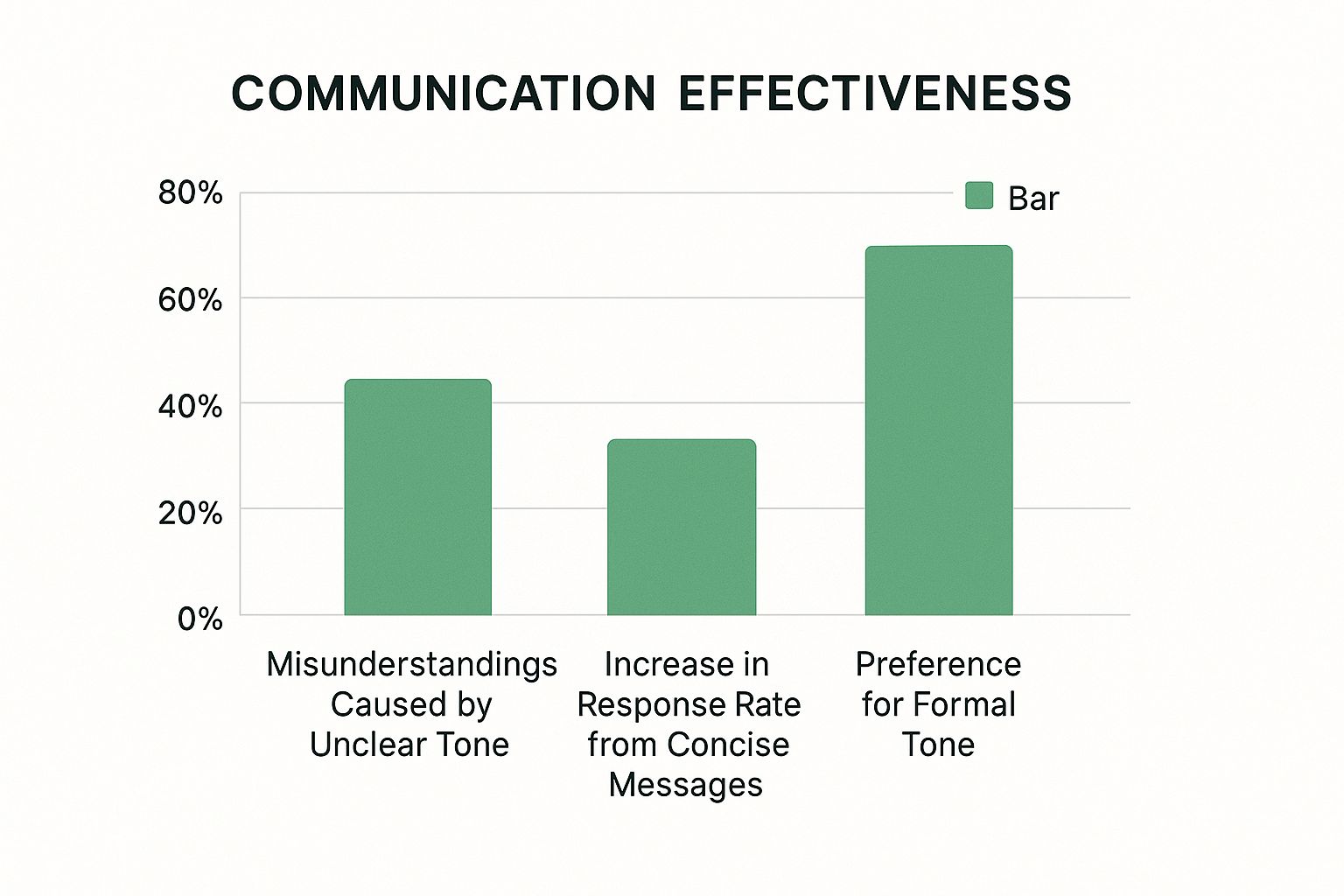
Transform Your Team With Business Writing Skills Training
June 10, 2025
Why Poor Writing Is Costing You More Than You Think
Let's be honest, unclear communication is a major, but often unseen, expense for businesses. Every confusing email, rambling report, or poorly written proposal can impact your bottom line. I've talked with so many executives who've experienced this firsthand. They've seen promising deals fall apart because of vague proposals and watched countless hours disappear into never-ending email chains – all because of unclear writing.
Think about your own experiences. How often have you stared at a convoluted email, wasting precious time trying to decipher its meaning? Now imagine that happening across your entire organization. Wasted time translates to lower productivity and, ultimately, lost revenue. It adds up quickly.
And it's not just about efficiency. Poor writing can seriously damage your company's reputation. A poorly worded email to a client can make you look unprofessional, putting valuable relationships at risk. Similarly, confusing internal communications can lead to mistakes and misunderstandings, impacting project timelines and team morale.
This isn't about being a grammar stickler or forcing everyone to memorize style guides. This is about understanding that training your team to write effectively is a smart investment. It's about empowering them to communicate clearly, concisely, and persuasively. The result? A healthier bottom line and a competitive advantage. A study highlighted just how important this is, revealing that two-thirds of employees write as part of their jobs, yet almost one-third aren't happy with their writing skills and feel they haven't received adequate training. A mere 37% find their company's feedback on their writing helpful. Discover more insights on business writing statistics.
The Real Cost of Unclear Communication
The consequences of ineffective business writing go way beyond minor annoyances. Here's a breakdown of some of the tangible costs:
- Lost Productivity: Think about how much time is wasted trying to understand confusing emails, rewriting poorly crafted documents, and clarifying ambiguous instructions.
- Damaged Client Relationships: Unprofessional or unclear communication can erode client trust and damage your company's image, potentially costing you clients and future opportunities.
- Missed Deadlines: When project requirements and timelines aren't clearly communicated, it can cause delays and expensive revisions.
- Decreased Morale: Frustration with confusing internal communication can negatively impact team dynamics and overall employee morale. No one enjoys feeling constantly out of the loop.
- Failed Projects: Proposals and reports that are poorly written can fail to secure the necessary funding or support, leading to abandoned projects and a significant waste of resources.
Investing in business writing skills training isn't simply about improving grammar and punctuation. It's about equipping your team with the crucial communication skills they need to thrive in today's competitive business world. It's about turning your communication from a potential weakness into a powerful asset. That’s a worthwhile investment that will pay off in the long run.
What Actually Works In Business Communication

Forget the flowery prose and tangled sentences. Business writing is about getting to the point—clearly and quickly. Your team needs to know that business writing plays by a different set of rules than academic or creative writing. Good business writing training emphasizes this. It's about understanding how busy people communicate and adapting your writing accordingly.
Think about how you read emails. Do you pore over every word, or skim for the important bits? Most executives are drowning in emails and don't have time to wade through walls of text. Brevity is king.
Persuasive techniques that work elsewhere can fall flat in business. Instead of emotional appeals, focus on logic, data, and clear benefits. Show, don't tell. Use concrete examples and measurable results to back up your claims.
The Power Of Structure
Imagine a report that jumps around without a clear direction. Frustrating, right? Structuring your writing logically is crucial. It ensures your message is easily understood and remembered, especially for longer documents like reports and proposals.
This means using headings, subheadings, bullet points, and other formatting to break up the text and guide the reader. It’s like creating a roadmap for your message. A well-structured document is easier to navigate, increasing the chances your key takeaways will resonate.
Good structure also boosts your credibility. A disorganized message can make you seem unprofessional, even if the information is solid. A clear, concise argument, on the other hand, shows professionalism and strengthens your position.
Examples That Resonate
Let's get practical. Imagine emailing a potential client. Instead of a generic "I'd like to discuss our services," try something like, "I'd like to discuss how our social media marketing services can increase your brand visibility by 20% next quarter." See how that highlights a tangible benefit and grabs attention?
But specific examples don't mean sacrificing personality. Your own voice and style can make your writing more engaging. The trick is balancing professionalism and authenticity. Your writing should reflect your expertise and connect with the reader. Maybe you'd be interested in improving your writing skills on naturalwrite.com.
Essential Vs. Optional Business Writing Skills
To help illustrate the core skills needed for effective business writing, let's look at a comparison table. This table outlines the must-have versus the nice-to-have skills and how they impact your business.
| Skill Category | Essential Skills | Optional Skills | Business Impact |
|---|---|---|---|
| Clarity | Concise language, active voice, logical flow | Figurative language, literary devices | Increased understanding, reduced miscommunication |
| Conciseness | Eliminating unnecessary words, focusing on key information | Elaborate descriptions, nuanced vocabulary | Improved efficiency, saved time |
| Persuasion | Data-driven arguments, clear benefit statements | Emotional appeals, abstract concepts | Increased buy-in, stronger proposals |
| Structure | Headings, subheadings, bullet points | Complex sentence structures, lengthy paragraphs | Improved readability, enhanced comprehension |
As you can see, the essential skills are all about clear, efficient communication.
These core skills are the foundation of effective business communication. Mastering them empowers your team to write clearly, concisely, and persuasively, ultimately driving better business outcomes. By focusing on practical application and real-world examples, business writing skills training can give your team the tools they need to succeed.
Building Training Programs That Create Lasting Change
Most corporate writing training falls flat. Why? It skims the surface instead of tackling the real issues. I've seen so many programs promise the world, only to vanish weeks later, leaving zero impact. Truly effective business writing training needs a different approach – one that actually shifts the communication culture within an organization. It's about understanding why some companies nail it while others struggle, even with big budgets.
Identifying Learning Styles and Challenges
A key ingredient for successful training? Realizing everyone learns differently. Some people love interactive workshops, while others prefer going solo with online modules. Some learn by doing, others by watching. A good business writing program has to cater to all of these learning styles. Think about mixing it up with interactive group sessions, online courses, personalized coaching, and even peer feedback.
Equally crucial is understanding your team's specific writing struggles. Are they wrestling with conciseness? Is structuring complex info a nightmare? Maybe they're just not sure how to adjust their tone for different audiences. Addressing those weak spots directly works way better than a generic, one-size-fits-all approach.
Creating Realistic Practice Scenarios
Let's be honest, grammar drills and theory rarely translate into real-world improvement. The best training? Hands-on practice that mirrors your team's daily writing tasks. Think simulated email exchanges with clients, drafting proposals using actual company data, or crafting presentations for internal stakeholders.
Imagine your sales team practicing persuasive emails, using real product info and handling common objections. Or your marketing team working together on a blog post, getting live feedback, and refining their message. This kind of real-world practice is instantly relevant, keeps people engaged, and speeds up skill development.
Building Accountability Systems for Continuous Improvement
Effective training isn't a one-and-done deal. It needs ongoing support to stick. This means building systems that encourage continuous improvement without feeling like Big Brother is watching. Regular feedback sessions, peer review groups, and easy access to resources like style guides and writing tools can all make a difference.
Accountability shouldn't feel like punishment. It's about fostering a culture of continuous learning where feedback is a growth tool, not a critique. Regular check-ins focused on progress are way more effective than high-pressure tests. And don't forget the fun stuff! Gamified elements like team challenges and friendly competitions can make learning more engaging and rewarding. The growth of the soft skills training market, which includes business writing, shows just how much demand there is for strong communication. In 2024, this market was worth USD 33.4 billion, and it's expected to hit USD 92.6 billion by 2033. Discover more insights on this growing market. Companies are clearly investing in these vital skills.
Addressing Resistance to Change and Measuring Real Progress
Rolling out new training programs often meets with some pushback. Some team members might be skeptical, while others might feel overwhelmed by another task on their already overflowing plates. Addressing these concerns directly is key. Clearly explain the benefits of the training, provide plenty of support and resources, and celebrate early wins to build momentum.
Finally, measuring the effectiveness of your training goes beyond simple before-and-after tests. It's about tracking real-world results. Think improved email response rates, happier clients, and smoother internal communication. By focusing on measurable outcomes, you prove the value of the training, justifying the investment and getting buy-in for future initiatives.

Exercises That Build Confidence And Competence
Theory is fantastic, but nothing beats hands-on practice when it comes to truly mastering business writing. Think of it like learning to drive: reading the driver’s manual is important, but you really learn by getting behind the wheel. Targeted exercises in a business writing training program bring that practical element to life. These exercises should closely resemble the everyday communication challenges your team faces, ensuring the training feels relevant and impactful.
Email Simulations That Mirror Reality
One highly effective exercise is email simulations. Instead of using generic prompts, design scenarios that reflect your company's specific communication style and common situations. For example, if your team frequently communicates with clients, simulate realistic client interactions. Have them draft emails responding to complex inquiries, addressing difficult complaints, or proposing innovative solutions. This practical, real-world practice not only builds skills but also confidence. It goes beyond simply writing; it teaches strategic communication.

This infographic highlights the impact of clear communication. It visualizes data showing how unclear tone contributes to misunderstandings (a whopping 60%!), the positive effect of conciseness on response rates (a 25% increase!), and the audience's preference for a more formal tone (75%). As you can see, clarity and conciseness are key, while an overly formal tone might not always hit the mark. If you're interested in diving deeper, check out this article on improving clarity and tone.
Report-Writing Workshops Using Actual Company Data
Report-writing workshops offer another valuable training opportunity. Instead of using hypothetical data, make it real. Incorporate actual company data to instantly boost relevance and engagement. Have your team analyze real sales figures, marketing campaign performance, or genuine customer feedback. Then, they can craft reports summarizing their findings and offering actionable recommendations. This teaches them to translate complex information into clear, persuasive narratives, backing up their arguments with solid data.
Peer Review Systems That Foster Growth
Building a culture of feedback is essential. Peer review systems, implemented thoughtfully, can offer invaluable insights without turning into an office drama. Set clear guidelines for constructive feedback, emphasizing specific areas for improvement over personal critiques. Encourage a supportive atmosphere where feedback is viewed as a tool for growth, not a personal attack. This not only improves individual writing but also strengthens team dynamics and creates a shared learning environment.
To give you a clear roadmap, here’s a table outlining how these exercises can progress as your team’s skills develop:
Progressive Training Exercise Framework Structured progression of writing exercises from beginner to advanced levels with expected outcomes
| Skill Level | Exercise Type | Duration | Success Metrics | Common Challenges |
|---|---|---|---|---|
| Beginner | Email simulations focusing on clear and concise language | 1-2 hours | Improved clarity, reduced word count, positive feedback from recipients | Overly formal tone, difficulty getting to the point |
| Intermediate | Report writing workshops using simplified company data | 2-4 hours | Accurate data interpretation, logical flow of information, persuasive recommendations | Difficulty synthesizing information, lack of data-driven arguments |
| Advanced | Report writing using complex company data and peer review | 4+ hours | Insightful analysis, impactful recommendations, constructive feedback integration | Overly complex language, difficulty incorporating feedback effectively |
This framework provides a structured approach, allowing you to tailor exercises based on skill level and track progress. Remember to adapt the duration and metrics based on your team’s specific needs.
Making Practice Sessions Enjoyable and Relevant
Nobody enjoys mandatory training that feels like a chore. Inject some fun and creativity into your sessions to keep your team engaged. Try gamification, team challenges, or even friendly writing competitions to make learning more interactive and motivating. The goal is to boost confidence and competence, not create another dreaded corporate requirement. When training is enjoyable, participation and retention increase, leading to genuine, long-term improvement in business writing.
Proving ROI And Justifying Training Investment
Let's be honest, convincing leadership to invest in training can feel like an uphill battle. They want to see a clear return on investment (ROI), and with business writing training, that's not always easy to demonstrate. It's not as simple as showing how many typos were fixed. We need to connect better writing to actual business results.
Measuring What Matters
Forget counting commas. Measuring the real impact of business writing training means tying it to your organization's Key Performance Indicators (KPIs). What are the metrics that really matter to your company?
Think about it this way: if your company prioritizes client satisfaction, you could track how clearer communication impacts client feedback. If productivity is a key concern, measure how much time is saved when everyone communicates clearly. Other useful metrics include project success rates, sales conversions, and even employee retention. Improved communication can touch all of these areas.
Here's a snapshot from Business Wire:
This shows the enormous size of the corporate training market, with business writing as a significant piece. It really highlights how important effective communication is becoming for organizational success.
Establishing Baselines and Presenting Results
Before you start any training, get a clear picture of where you're starting from. Establish baselines for your chosen metrics. Gather data before the training, then gather the same data again afterward. This before-and-after comparison is crucial for demonstrating the training's impact.
Presenting your findings is equally important. A raw spreadsheet won't cut it. Instead, tell a story that connects better writing to the positive outcomes you've measured. Use charts and graphs to visualize the improvements.
Remember, different people care about different things. A CFO will be interested in cost savings. A sales manager will focus on increased sales. Tailor your presentation to highlight the benefits that resonate with each decision-maker. For example, the global corporate training market (including business writing) is projected to reach nearly USD 200 Billion by 2030, with a CAGR of 8.3%. This shows a growing investment in skills like communication. Discover more insights on the corporate training market.
Building a Culture of Communication
Effective business writing isn't a one-and-done deal. It's about creating a workplace where clear, concise communication is valued. This takes ongoing effort. Think continuous improvement, not just a single training session.
Integrate writing best practices into performance reviews. Give people chances to practice and improve. Encourage peer feedback and create a safe environment for questions.
By building this kind of culture, you'll see long-term returns on your training investment. The benefits will ripple throughout your organization, impacting everything from client relationships to internal teamwork.
Self-Assessment And Continuous Improvement

The best writers I know are constantly learning. Likewise, the most effective teams understand that real growth goes beyond a single training session. They build systems for ongoing development. This doesn't have to be some huge, complicated thing. It’s about creating a culture where improvement is the norm and giving people the tools to make it happen. Let’s talk about how to keep that momentum going long after the initial business writing training wraps up.
Practical Self-Assessment Methods
Knowing where you stand is the first step to getting better. Honest self-assessment helps people figure out their communication strengths and weaknesses. This isn't about beating yourself up; it’s about taking an honest look. Think about using different approaches: analyzing writing samples, getting feedback from colleagues, or even trying online writing assessments. Each one offers a unique perspective. Combining them gives you a much clearer picture of your writing skills.
For example, looking back at old emails or reports can reveal patterns in your writing style, tone, and how clearly you’re getting your point across. Peer reviews give you valuable outside opinions and highlight blind spots you might miss when reviewing your own work. Online assessments offer structured feedback and let you see how your skills stack up against industry standards. By mixing these methods, you can pinpoint the specific areas where focused effort will make the biggest difference.
Personal Development Plans and Writing Habits
Once you know your strengths and weaknesses, it's time to build a personal development plan. This should be tailored to your specific needs and fit into your existing workload. It’s not about adding more work; it's about making small, consistent improvements part of your day-to-day routine. Try setting aside 15-20 minutes each day for focused writing practice. You could review well-written examples from your industry or work through targeted online exercises.
Good writing habits, like any habit, build over time. The more you write, the better you’ll get. Short, regular practice sessions are much more effective than trying to cram it all in at once. This means setting achievable goals, blocking off dedicated practice time, and zeroing in on areas you want to improve. These small daily efforts will add up to some serious progress. You might find this helpful: learning more about humanizing AI text on naturalwrite.com.
Building Feedback Loops and Staying Current
Getting good feedback is key for ongoing development. Think about setting up feedback loops that accelerate growth without piling on extra work. Peer review partnerships, where colleagues swap critiques and insights, are a fantastic way to do this. This collaborative approach not only improves individual writing, but it also builds a culture of shared learning and support.
Staying up-to-date on communication trends is also essential. The business world changes constantly, and so do the best ways to communicate. Encourage your team to explore industry blogs, join online communities, and attend workshops or webinars that focus on communication trends. This helps them adapt and refine their writing skills as their roles and the business landscape evolve.
By using these strategies, organizations can create a culture of continuous writing improvement. This means clearer communication, stronger teams, and ultimately, more success. It's a shift from one-off training events to a continuous, integrated learning process that strengthens writing across the entire organization.
Your Implementation Roadmap For Writing Excellence
Alright, let's put all this good stuff into practice. This roadmap pulls everything together into a clear, actionable plan you can start using today. Whether you're at a tiny startup or a massive corporation, these steps will work. We'll look at realistic timelines, common roadblocks, and practical tips for smoothing out any wrinkles along the way.
Planning Your Business Writing Skills Training
First things first: figure out what your organization really needs. A solid needs assessment will pinpoint the exact writing skills gaps in your team. This means looking at actual writing samples, asking employees about their writing struggles, and understanding the communication demands of different roles. For example, your sales team might need a boost in persuasive writing, while customer service might need to focus on clear, empathetic communication.
Realistic Timelines and Implementation Challenges
Let's be realistic: improving writing skills takes time. It's a marathon, not a sprint. A short, intensive workshop can jumpstart the process, but real, lasting change requires consistent effort. A one-day workshop is great for introducing new concepts and techniques, but those skills need ongoing practice and feedback to really stick. Think weeks and months, not just days.
Rolling out any new training program has its challenges. Getting everyone on board is a big one. Some people resist change, while others might feel they don’t have time for extra training. Address these concerns directly. Explain the benefits clearly, both for individuals and the organization. Offer plenty of support and make the training as accessible and engaging as possible.
Troubleshooting and Maintaining Momentum
Even the best-laid plans can go sideways. Having a backup plan is essential. Let's say your in-person workshop gets cancelled – have an online alternative ready. Or, if some team members struggle with a specific concept, offer extra support or one-on-one coaching. Flexibility is key.
Keeping the momentum going after the initial training is just as important. Create opportunities for continuous practice and feedback. Maybe start a writing community within your organization where people can share their work, offer suggestions, and learn from each other. Regular refresher courses and advanced workshops can also help people keep sharpening their skills and stay current with communication best practices.
Ready to take your team's writing to the next level and unlock its full potential? See how Natural Write can help you achieve writing excellence and boost your business communication today!


